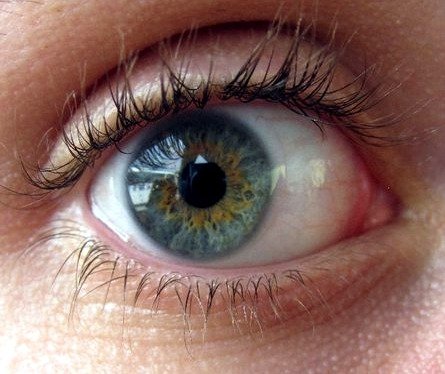It was about to rain as I was returning home some days ago, the weather was so cloudy and accompanied with heavy wind, the wind blew so heavily that it deposited some debris in my eye. I managed to get home but I got stuck with some of these dirt in my eyes. I couldn't get some remnants of the particles out easily, it started to make my head ache as I felt pained anytime my eyes blinks.
For the first time, I took my time very well, observing my eyes standing right in front of the mirror, trying to get rid of the debris but all efforts proved abortive. Then I went online to search for the best and easiest ways of getting debris out of the eyes. Later, I took some drugs and slept, I woke up with my eyes cleared the next morning. Lucky me you'd say right? But I believe I'm not the only one who doesn't like getting stuck with debris in the eye for a long time. The uncomfortable feeling isn't just a good one to think of.
Fortunately for me I'd say, It was during the online search for remedy I came across the floaty thread-like particles which can be found in the eye. They are called Eye Floaters! The very first time I'd come across such. This inspired a research on this spring-like particle which I would love you all to have the knowledge coupled with some scientific explanation.
Welcome to my blog this time again, I hope you'll learn a little about Floaters found in the eye.

Webomedia Creative Commons: Eye Floaters
The human eyes is the sense organ that allows vision. It's such a complex organ that provides us with vision, but not just that.
What if I told you that the eye has the ability to differentiate millions of colours! Interesting? Why not let me get your knowledge refreshed a little about parts and functions of the eyes as this will also help in understanding all about the so-called eye floaters.
Major Parts of the Eyes
The Cornea:
This forms the outer part of the eye, protecting the inner part of the eye from foreign elements, light enters the eye through the cornea, helps in focusing light effectively for production of clear images.The Pupil:
This the black circle in the middle of the eye, an opening to the inner part of the eye which monitors the amount of light entering the eye.The Lens:
The Lens is the part of the eye found behind the pupil, it focuses the light received by the pupil allowing you to focus on small word found while reading. The lens is an elastic capsule which adjusts to accommodate the input received, it loses it elasticity with age, reason aged people tend to make use of artificial lenses as found in glasses when the eyes lenses elasticity are lost.The Iris:
This is that coloured ring surrounding the pupil. It basically adjust the the size of the pupil with muscles that expands and contracts as the image the pupil need to process is required.The Retina:
This is found behind the eye, a light-sensitive tissue made up of cells which basically receives visual images and sends to the brain for interpretation.Vitreous Humor:
: The Vitreous humor is the fluid the eye contains, it fills up the eyeball helping the eye maintain its shape.
All parts of the eye works together for visibility to be attained..!
What are Eye Floaters?
If you've ever noticed tiny thread-like strings, not the blood vessels, but a worm-like floaty substance drifting around when you move your eyes and surprisingly disappears the more you try to focus on them and reappears when you about to give up.. You definitely not insane but the floaters just played a prank on you.
Floaters are optical illusion in the eyeball which appears as spot moving across your field or area of vision found in the Vitreous humor of the eye..Floaters are part of body cells and tissue (not actually some sort of foreign elements) which break loose and find their way to the eyeball to throw shades on the retina. Floaters in Latin is referred to as 'Muscae volitantes' translated as 'flying flies' suspended in the Vitreous humor (the gel-like fluid that fills the eye) drifting around the fluid.
When floaters are firstly noticed in the eye, the first attempt we make is to focus our attention on this strange particles but may seem difficult or rather impossible to catch up a longer gaze on them as floaters moves with the motion of the eye controlled by the eye viscous liquid. Take some time with the video below:
How do Floaters Come-by?
Floaters are formed when tissues, red blood cells, and clumps of protein found in the Vitreous humor fluid comes together, to make up the floating strings.
At tender age, the vitrous humor fluid (gel-like) is found very clear but as we age, this gel liquefies developing strands or deposits and are seen as floaters dfriting around the field of vision. Eye floaters may appear thin, thick or branchy. They are noticeable under clear lighting condition or when looking at a bright sky. Eye floaters are common in adult and certainly everyone will tend to develop this towards the age of 70 as it grows with time( as we age). However, being myopic (a condition of the eye that makes it difficult to see objects that are far away) is one of the tendency of getting floaters earlier in life. Diabetis and eye injury also causes the development of eye floaters.
Are Eye Floaters Dangerous?
Eye floaters are naturally not dangerous but may be very annoying and provoking, most are caused due to aging but sudden occurrence of floaters will require to see an ophthalmologist for medical attention to ascertain it's not as a result of eye abnormality or disease as sudden onset of eye floaters may result in the retina tear and detachment which may result in loss of vision if proper care is not taken ASAP
Ways of Preventing Eye Floaters
At present, there is no way to prevent the normal eye floaters from occurring, but floaters resulting from injuries and diabetic condition can be prevented by using safety goggles while working with substances or object that can be harmful to the eye and appropriate control measures for diabetics.
Conclusion
The ability to understand and appreciate something seen is such a wonderful phenomenon the eye performs. Floaters are floaty thread-like particles found in the eye which appear as spots and tend to create nuisance on our field of vision. Floaters are naturally not dangerous but can be very annoying and worrisome. Eye floaters develops as we age but may occur earlier in life due to eye injury or health issues which therefore requires medical attention. All eye-related issues are worth seeking quick medical attention so as to prevent severe damage to the eye.
Eye floaters is one of the things I've learnt during the week and I hope it's a time well spent reading through..Thanks for stopping-by!
REFERENCES
If you write STEM (Science, Technology, Engineering, and Mathematics) related posts, consider joining #steemSTEM on steemit chat or discord here. If you are from Nigeria, you may want to include the #stemng tag in your post. You can visit this blog by @stemng for more details. You can also check this blog post by @steemstem here and this guidelines here for help on how to be a member of @steemstem. Please also check this blog post from @steemstem on proper use of images devoid of copyright issues here.


Thank you for your contribution. Dont forget to link references and sources when applicable!
=======================================================================================
This post was upvoted and resteemed by Steemgridcoin with the aim of promoting discussions surrounding Gridcoin and science.
This service is free. You can learn more on how to help here.
Have a nice day. :)
Downvoting a post can decrease pending rewards and make it less visible. Common reasons:
Submit
When I was growing, I use to play with those floaters. They keep me sometimes occupied, cos I have to constantly run after them with my eyes. And I used to think it was time to de-worm. But thanks for sharing
Downvoting a post can decrease pending rewards and make it less visible. Common reasons:
Submit
Too bad, that's to say you didn't have friends growing up 😂 😂
Downvoting a post can decrease pending rewards and make it less visible. Common reasons:
Submit
C'mon. 😃
Downvoting a post can decrease pending rewards and make it less visible. Common reasons:
Submit
@olajidekehinde interesting article, thanks for sharing.
Downvoting a post can decrease pending rewards and make it less visible. Common reasons:
Submit
Good job bro. hmmm! "eye-floaters" i don't think i have ever come across that word. Now i know what they mean thanks to your simplified post. but are they responsible for constant eyestrain??
Downvoting a post can decrease pending rewards and make it less visible. Common reasons:
Submit
It's not found to be responsible for that. However, a sudden increase in the number of floaters can be found dangerous to the eye which may have numerous effect on the eye.
Downvoting a post can decrease pending rewards and make it less visible. Common reasons:
Submit
Alright! Thanks for putting this to my knowledge
Downvoting a post can decrease pending rewards and make it less visible. Common reasons:
Submit
Informative. I have seen something like this before but then i never knew the name
Downvoting a post can decrease pending rewards and make it less visible. Common reasons:
Submit
Very nicely written article about a topic that affects us all :)
Downvoting a post can decrease pending rewards and make it less visible. Common reasons:
Submit
I had one of these about 20 years ago. Now it is gone.
Downvoting a post can decrease pending rewards and make it less visible. Common reasons:
Submit
I certainly know what they are, just never knew what they are called. Thanks for this eye opener.
Downvoting a post can decrease pending rewards and make it less visible. Common reasons:
Submit
Congratulations @olajidekehinde! You have completed some achievement on Steemit and have been rewarded with new badge(s) :
Click on any badge to view your own Board of Honor on SteemitBoard.
To support your work, I also upvoted your post!
For more information about SteemitBoard, click here
If you no longer want to receive notifications, reply to this comment with the word
STOPDownvoting a post can decrease pending rewards and make it less visible. Common reasons:
Submit
Hmmm, "eyes floaters"...I probably have seen it many times helping someone to "blow" his/her eyes of dirt...But then, this post confirmed that..
Thanks for this
Downvoting a post can decrease pending rewards and make it less visible. Common reasons:
Submit
very enlightening,this is a good write
up.
Downvoting a post can decrease pending rewards and make it less visible. Common reasons:
Submit
when i was little, i used to "play" with these things in my eyes... Bouncing them up and down.
Informative one bro. Keep it up
Downvoting a post can decrease pending rewards and make it less visible. Common reasons:
Submit